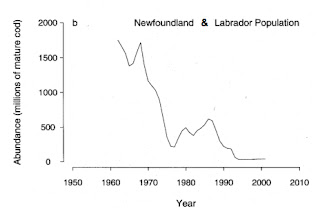- Baby Beluga in the Deep Blue Sea
- Northern Wolffish
- Banded Killifish
- American Eel
- Marine Recovery Plans
 |
| Atlantic Cod (retrieved from: http://upload.wikimedia.org/wikipedia/commons/a/a3/Atlantic_cod.jpg) |
The atlantic cod (gadus morhua) is a large marine fish residing in both sides of the North Atlantic waters. On the western side, cod ranges from North Carolina to Greenland along with the Flemish Cap. This species of cod is currently listed as "Special Concern" by SARA (Species at Risk Act) and is listed as "Endangered" by COSEWIC (Committee on the Status of Endangered Wildlife in Canada). It is also labelled Vulnerable on the IUCN Redlist (International Union for the Conservation of Nature). What is the reason behind these listings you ask? Probably the cod moratorium.
 |
| Cod Landing from 1850 to 2000 (retrieved from: http://upload. wikimedia.org/wikipedia/commons/thumb/b/bc /Atlantic-Cod-Stocks.jpg/773px-Atlantic-Cod-Stocks.jpg) |
 |
| NL Cod Abundance (retrieved from: http://www.sararegistry.gc.ca /virtual_sara/files/cosewic/sr%5Fatlantic%5Fcod%5Fe%2Epdf) |
"Cod in the inshore and offshore waters of Labrador and northeastern Newfoundland, including Grand Bank, having declined 97% since the early 1970s and more than 99% since the early 1960s, are now at historically low levels. There has been virtually no recovery of either the abundance or age structure of cod in offshore waters since the moratoria imposed in 1992 and 1993. Threats to persistence include fishing (now halted), predation by fish and seals, and natural and fishing-induced changes to the ecosystem."Currently, the government have the cod moratorium still in effect to help with the recovery of the species. This moratorium makes it so it is illegal to fish cod commercially. This is the main recovery plan currently in place by the Canadian federal government (including NL provincial government).
Want to learn more? Visit these fine websites:
http://www.heritage.nf.ca/society/moratorium.html
http://www.sararegistry.gc.ca/species/speciesDetails_e.cfm?sid=549
http://www.sararegistry.gc.ca/virtual_sara/files/cosewic/as%5Fatlantic%5Fcod%5Fe%2Epdf
http://www.dfo-mpo.gc.ca/fm-gp/initiatives/cod-morue/strategie-qc-eng.htm
http://www.sararegistry.gc.ca/virtual_sara/files/cosewic/sr%5Fatlantic%5Fcod%5Fe%2Epdf
No comments:
Post a Comment